Wildlife Crime Penalties Review Group: report
Report from the review group commissioned by Scottish Government to examine whether the penalties for wildlife crimes were adequate and a deterrent.
8. Stakeholder engagement questionnaires and interviews: summary of responses

Damaged bat roost © John Haddow
Methods
58. The Group sought a range of stakeholder views on penalties. This was not intended to be a full public consultation and timescales for responses were more restricted than would have been the case for a full consultation. If the Scottish Government does decide to take forward any of the recommendations in this report it is understood that full consultations will be carried out on any proposals as appropriate.
59. The questionnaire was sent to PAW Scotland stakeholders and put on the PAW website so that it was publicly available. 68 responses were received to the questionnaire, 20 from governmental and non-governmental organisations and 48 from individuals. Respondents identified themselves variously as being based in Scotland, England, Wales, Great Britain, the UK and the Republic of Ireland.
60. Eighteen questionnaire respondents were invited to interview. A representative sample of respondents was chosen from governmental and non-governmental organisations and individuals. In the interviews respondents were asked to elaborate on or explain their questionnaire responses around the level of penalties, whether they were a deterrent, what types and levels of penalties might act as a deterrent and what alternative penalties or approaches might be considered. It became apparent in the interviews that some questionnaire rankings had been mistakes: thus one respondent had ranked badger baiting as lower than snaring but had meant to rank it higher [54] . In addition, given that penalties are only a part of the context of wildlife crime, interviewees were also asked more general questions about their views of the prevention of wildlife crime to provide a wider perspective. Several respondents had raised such issues in their questionnaire responses and it therefore seemed appropriate to follow these up.
61. We undertook that we would not identify respondents to the questionnaire survey or interviewees and have simply referred to them here by a questionnaire response number or an organisation or individual interview number reference. We have cited responses in interviews in the following paragraphs where appropriate in order to indicate whether a preponderance of interviewees favoured or did not favour a particular approach or point and how that broke down between individual interviewees and those interviewees representing organisations. However, this is merely to give an indicative impression of the range of views. Letters were also received from three organisations.
62. In presenting the results of the stakeholder engagement we have attempted to group responses thematically around a number of issues.
63. Not every respondent answered each question, nil responses have been excluded from the graphs and the graph segments represent the proportion of comments made.
64. It is important to note that in the following paragraphs of this chapter we present the views expressed by stakeholders in responding to the questionnaire or in the interviews. These paragraphs do not represent the views of the Review Group itself. Our views are presented in Chapter 9, below.
Deterrent effect of penalties and their appropriateness
Q1. Do you consider that the penalties available to the courts for wildlife crime in general are a deterrent?
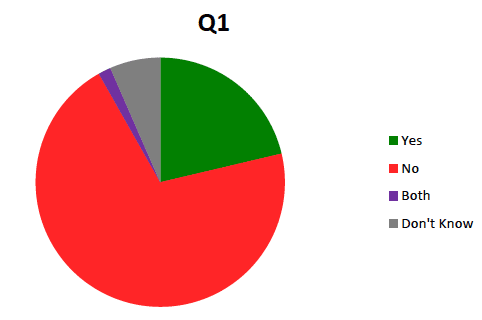
Q2. Do you consider that the penalties imposed by the courts for wildlife crime in general are a deterrent?
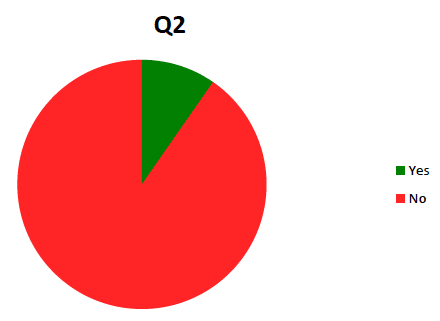
Q3. Are there any particular sorts of wildlife crime where you believe the penalties imposed are not appropriate?
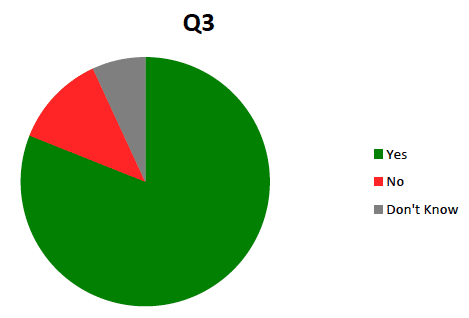
Q4. Are there any particular sorts of wildlife crime where you believe the penalties imposed are appropriate?
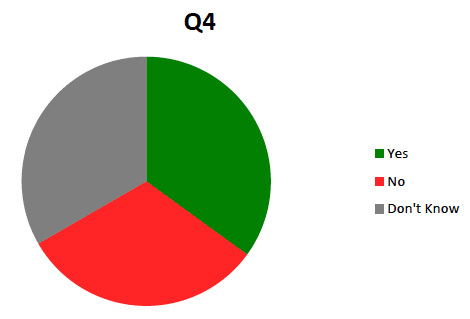
Q5. Are wildlife crime penalties:
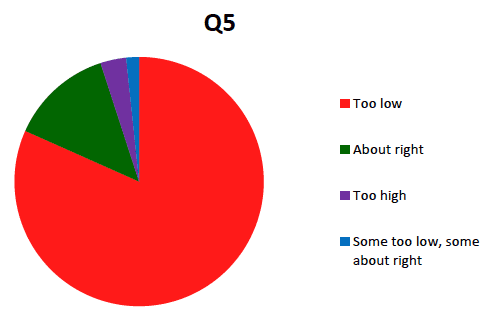
Q6. On a scale of 1 to 5, where 1 represents minor regulatory offences and 5 represents the most serious offences such as murder, where would you place the following offences?
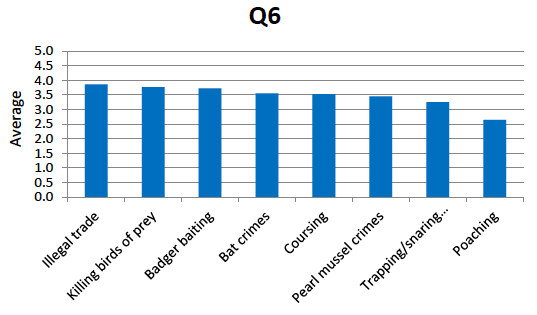
Q7. Which of following [court admonishment, court fine, community payback order ( CPO), prison] would be appropriate for the following offences?
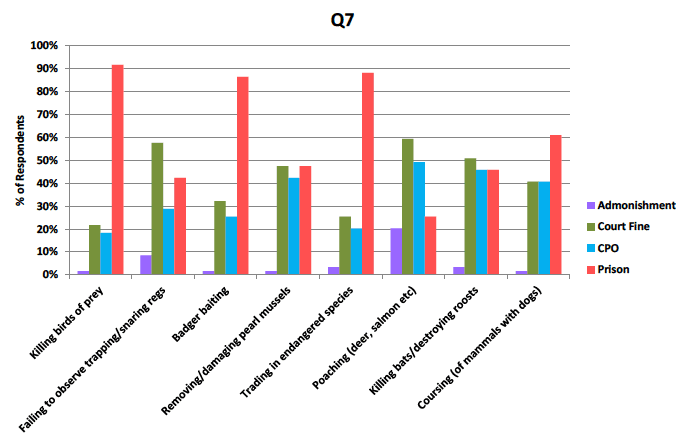
Questionnaires
65. The responses to Question 1 demonstrate a widespread majority view amongst respondents that the penalties available to the courts for wildlife crime were not a deterrent. Reasons given by respondents included that the potential benefits of the offence to the offender could significantly outweigh deterrent effect of penalties and that corporate developers, for example in relation to bat crime, tended to comply with the law because of reputational concerns rather than the deterrent effect of the penalty.
66. For Question 2 an even larger majority of respondents than in Question 1 considered that the penalties imposed by the courts for wildlife crime were not a deterrent. Probing further regarding the appropriateness of penalties imposed, in answer to Question 3, a majority of 71% considered they were not appropriate in particular sorts of wildlife crime. However, in answer to Question 4 around one third (32%) of respondents indicated that there were areas of wildlife crime where the penalties imposed were appropriate. A slightly smaller proportion (29%) considered that this was not the case and a similar proportion indicated they did not know (30%). However, when asked in Question 5 if the penalties imposed for wildlife crime were too low, about right or too high, nearly three-quarters of respondents indicated that they were too low. Concern was again expressed that the economic benefit from the crime may outweigh the penalty.
67. These answers suggest that there is a perception that, within a range of penalties which are widely perceived as inadequate in terms of their deterrent effect, the courts are failing to make full use of the penalties that are available. This is reinforced by comments made by respondents to Question 2. It is nonetheless clear that, while in general terms there is a clear perception that penalties imposed are too low, there are some areas where it is considered that the penalties imposed are appropriate. Given the breadth of wildlife crime and the relative seriousness with which respondents viewed different wildlife crimes relative to each other and non-wildlife crimes, this is not surprising.
68. In relation to relative seriousness of types of wildlife crime in Question 6, while there was not much distinction between the respondents' top-rated wildlife crimes (trading in endangered species, killing of birds of prey and badger baiting) the lowest rated crime is clearly poaching.
69. In relation to Question 7 the types of penalties considered appropriate roughly reflect the respondents' views of seriousness of types of wildlife crime, albeit that prison is seen as the most appropriate option for killing birds of prey by 92% of respondents while 88% saw it as appropriate for trade in endangered species and 86% for badger baiting. Prison was seen as least appropriate for poaching (25%) in line with its position as the least serious wildlife crime of those mentioned. Admonishment was seen as appropriate by the smallest proportion of respondents who answered this question, with only 20% seeing it as appropriate for poaching offences - again reflecting the fact these are seen as the least serious wildlife crime. (The figures total more than 100% for each category of wildlife crime as respondents were able to select more than one option for each category).
Interviews
Extent to which criminal penalties and other considerations deter wildlife crime
70. Amongst the interviewees there was a general view that some recent developments could ensure that the law had a greater deterrent effect. In particular, the custodial sentence imposed on a gamekeeper and the knock-on consequences of that (loss of employment etc.), the vicarious liability conviction and a perception of greater use of appropriate forfeiture provisions [55] . Vicarious liability had made landowners more aware of their responsibilities [56] and some considered it more important to target organisational bad practice rather than employees who might not know any better [57] . Nonetheless there were mixed views on the deterrent impact of large fines on landowners or shooting tenants with some saying this was a deterrent for the wealthy along with the shame of conviction. [58] However, other interviewees indicated such fines were not a deterrent as some landowners and shooting tenants were not so concerned about their public image as, for example, corporate entities which might commit pollution offences under other areas of environmental law [59] . Only loss of subsidies and/or a shooting licence (if such a thing were to be introduced) would be a deterrent for such offenders. Landowners were also now more aware of the knock-on effects relating to cross compliance [60] . Fines were not seen as a deterrent for raptor crimes because there was a perception that gamekeepers convicted of offences had these paid by their employers [61] . They were also not always seen as a deterrent because they could be paid off over a period [62] or simply because those involved in activities such as badger baiting simply could not pay significant fines [63] . However, some indicated that there was a case for higher maximum penalties where the impact was greater, such as the introduction of non-native species or crimes involving European Protected Species [64] . Fines were also often lower than the economic benefit from the crime such as badger sett interference for otherwise lawful forestry, agricultural or development activities [65] . Some respondents considered that short custodial sentences for gamekeepers convicted of offences were not seen as a deterrent per se but rather the consequences of such sentences ( e.g. loss of accommodation, job etc.) [66] . Custodial sentences were seen as having been a major deterrent for egg collectors as egg collecting offences had declined markedly since custodial sentences were first imposed a decade ago [67] . Custodial sentences were also generally seen to be appropriate for cases involving significant deliberate cruelty [68] but the lack of re-education offered in such cases was also criticised [69] . One interviewee noted that prisons were already overcrowded so custodial sentences were not always desirable [70] . Another interviewee took the view that custodial sentences were only appropriate for CITES offences because of the deliberate and often large scale nature of the wrongdoing [71] . Community Payback Orders were seen as more appropriate by one individual as they could ensure some degree of re-education of the offender in terms of damage to an ecosystem or local tourism [72] . The shame of a conviction was seen by some as a potential deterrent regardless of the level or nature of penalty imposed [73] .
71. The risk of getting caught was seen as a deterrent but a number of interviewees noted both that it was difficult to get the evidence for a conviction and that those involved in organised wildlife crime were well aware of this, with a high number of 'No comment' interviews given to the police [74] . The introduction of legal presumptions was proposed, for example, that possession of a banned poison might be presumed to be evidence of its use if a bird on a particular estate had been killed by that type of poison [75] .
72. Limits to the deterrent effect of any penalties were also acknowledged in the discussion of the deterrent effect of penalties and one organisation noted that beyond deterrence might lie the possibility of re-education on the same basis that those committing speeding offences might be required to attend education courses on the impact of speeding [76] .
Appropriateness of level of penalties imposed by courts
73. A general view discerned in the answers of interviewees is that sheriffs need to be able to impose appropriate penalties to reflect the nature and seriousness of the crime [77] and in turn this was seen as requiring a greater maximum to encourage and enable sheriffs to impose higher penalties where justified (not least to ensure that the fine level exceeded the economic benefit from the crime or its perceived seriousness [78] ). This was despite the fact that existing penalties did not approach the present maximum sentences. There was certainly a view that sheriffs were not imposing appropriate penalties at present. [79] . This suggested that in the case of individuals at least, sheriffs were actually imposing the right fine levels. Public lack of awareness of these issues was seen as a reason why there was public criticism of the judiciary, which was not always justified [81] . Inaccurate reporting of cases by the media also did not help public understanding [82] . However, another possible factor in the imposition of low penalties was that the impact of the offences had not been adequately explained to the court [83] .
74. Harmonisation of penalty levels within wildlife crime was needed to enhance the appropriateness of penalties imposed and hence their deterrent effect. This could be informed by what has occurred in other areas of environmental law [84] . Some interviewees noted that waste law might be a good parallel since offences there ranged from the accidental to the deliberate money-saving and even to organised and violent crime [85] . It had to be recognised that there were many types of offenders with different motives committing wildlife crimes which makes having the same set of rules very difficult [86] . One interviewee also pointed out that while commercial entities were commonly involved in environmental crime and fines of £10,000 or more would mean little to such bodies such organisations were rarely involved in wildlife crime [87] . More than one interviewee indicated that prosecution on indictment should be more widely available in wildlife crime [88] .
75. The fact that the main summary conviction fine levels had not been uprated in 34 years was noted, even to account for inflation [89] . However, another aspect of this was that in some cases neither fines nor custodial sentences were appropriate but rather, for example, forfeiture of dogs and banning individuals from keeping dogs in the case of badger baiting or vehicles, animals used and equipment in case of poaching [90] . The inconsistency of available penalties and, for example, the availability and extent of forfeiture penalties was noted by some [91] .
76. Some interviewees indicated that the right penalties were in place but that the full range was not being used [92] . They also considered that the wider consequences of conviction on the likelihood that a gamekeeper would lose his job and/or his firearms licence should not be lost sight of [93] . The police were seen as being more proactive in revoking firearms certificates following convictions even where no firearms were involved [94] .
Comparative seriousness of wildlife crime
77. Not all interviewees were questioned about this. Questions were asked where the particular interviewee's response was out of line with the average questionnaire results.
78. Although poaching had tended to be ranked lower in the questionnaire responses than other forms of wildlife crime, some had ranked it at the same level because it could involve significant and deliberate cruelty [95] .
79. Some government organisations ranked certain wildlife crime higher than some NGOs which had taken a more measured approach accepting that wildlife crime could be dealt with by custodial sentence but was clearly not as serious as murder [96] . Another NGO indicated that its members' views on relative seriousness of wildlife crimes were more severe and that influenced its questionnaire response but that the NGO itself took a less severe view [97] .
80. Another NGO ranked all wildlife crime at the same mid-ranking level [98] . By way of explanation the NGO indicated that there was a range of conduct within each offence category so that while poaching might be seen as less serious it could nonetheless involve organised crime. Furthermore while other offences could involve premeditation and hence be viewed as more serious nonetheless there might be mitigating factors operating in some cases.
81. A further NGO ranked all wildlife crime in their questionnaire response at the highest level, on a par with murder. However, in the interview they did concede that there could be variations and that certain wildlife crime was less serious. Thus, for example, they saw deer coursing as being worse than the illegal, but clean shooting of deer.
Impact
Q8. On a scale of 1 to 5, where 1 represents "not at all" and 5 represents "completely", to what extent do you think that Scottish criminal courts should take into account the impact of wildlife crime when sentencing?
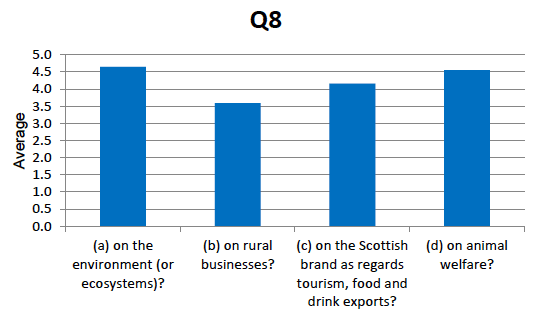
Questionnaires
82. As can be seen from the answers to Question 8 above, there was widespread support from respondents for the greater use of impact statements in wildlife crime prosecutions. Respondents were generally positive in their support for impact statements particularly in relation to the conservation/ecological impact. Some commented that where the impact of the offence was presented to the court the penalties tended to be more of a deterrent.
Interviews
83. There was strong support for the use of impact statements as a matter of course in wildlife crime cases [99] . It was noted that, where impact statements were provided, the perception was that they were effective. However it was noted that this was not a consistent practice, although it was not made clear by the interviewees which parties were responsible for this [100] . The focus was very much on the use of such statements in the context of the impact on the conservation status of the species or the relevant ecosystem. It was pointed out that it was difficult for police, procurators fiscal or sheriffs to understand the impact of the destruction of Fresh Water Pearl Mussels on a river ecosystem without an impact statement [101] . It was also noted that the conservation impact of a crime might differ considerably depending on the location [102] . Impact statements could also be appropriate in the context of welfare or cruelty cases that were not a conservation concern [103] .
84. However, all interviewees recognised it was difficult to present evidence about, for example, the economic impact of crimes on eco-tourism or even the economic benefit that might accrue in some cases from unlawful conduct. Although this had been done in some cases there needed to be reliable information which could be substantiated [104] . This was seen as easier to estimate in the context of, for example, destruction of bat roosts as part of a new development [105] . However, an NGO did indicate that the economic value of raptor crime to a sporting estate ought to be estimated [106] . It was also noted that work had been done in Finland to place an economic value on wildlife and hence to inform the setting of penalties. [107] (This is considered elsewhere in the report [108] ). Even if there might be an impact on Scotland's 'brand' or as a tourist destination, hard evidence of this was extremely difficult to produce [109] .
85. It was the view of some interviewees that the practice of plea adjustment - plea bargaining - could and sometimes did undermine the value of impact statements as the impact related to charges which were dropped as part of the adjustment [110] . Thus, although a guilty plea might be obtained through this process, the charges and thus the penalties imposed might not fully reflect the actual impact. However, other interviewees noted that members of the public might not understand this aspect of the criminal justice system [111] .
86. Those interviewed were also asked about who might prepare such statements. Interviewees generally considered that SNH should provide conservation/ecosystem impact statements as it would be considered impartial in contrast to NGOs which had vested interests [112] . However, it was also suggested that the body with the greatest expertise should provide the impact statement or at least assist in doing so [113] or that environmental consultants or community partnerships in former privately -owned estates might be seen as impartial in those areas [114] . It was clear though that NGOs had been invited to produce impact statements or opinions or to act as expert witnesses on occasion where they were seen as experts [115] . Provision of impartial and factual information was seen as key [116] . In this context one interviewee noted the difference between campaigning NGOs and those which simply commission, collate and publish information such as the British Trust for Ornithology: the latter could be seen as reputable and neutral sources of information [117] . It was noted that SNH had provided 5 impact statements within the last year and that it had the specialists and resources to undertake this role. Natural England had been doing this for years and it had resulted in higher penalties. However, others took the view that SNH was under severe resource constraints [120] and was unlikely to be able to do this perhaps outside European Protected Areas [121] . In welfare or cruelty cases interviewees considered that a vet could provide the relevant impact statement [122] .
87. NGO representatives indicated that they had been invited to act as experts and were willing to do so or to work in partnership with others in providing impact statements [123] . Some NGOs indicated that while they worked with the police south of the border this did not happen in Scotland [124] .
88. In terms of ensuring systematic provision of impact statements a legislative change was seen as preferable to a new administrative practice [125] . It was also pointed out that the Court could order its own independent impact statement and that this could be done at the stage when pleas had been negotiated and so could reflect a reduced number of charges [126] .
Alternative penalties
Q9. Do you think that different or additional penalties, other than those listed in Q7, should be available to the Scottish criminal courts to deal with wildlife crime?
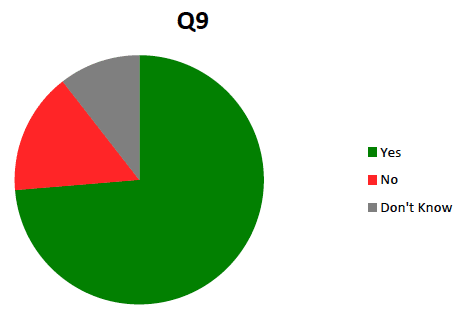
89. In the case of some offences it is clear that it is not the threat or imposition of a fine or custodial sentence that acts as a deterrent but it is the additional penalties which the court has the power to impose that act as a more significant deterrent. These might include the seizure of equipment, vehicles or animals involved in the commission of the offence and have been discussed above in some detail.
90. There was strong support from questionnaire respondents for the use of alternative penalties. These included forfeiture provisions, cancelling firearms and shotgun certificates, cross compliance issues but also potential re-education and rehabilitation.
91. In their letter to the group the PAW Legislation, Regulation and Guidance Group made a representation for more systematic links between the commission of wildlife crimes and the granting or continuation of holding various forms of official permits [127] . Noting that while there was a clear link in the case of General Licences which cannot be held or continue to be held by those convicted of such offences, the position was less clear, for example, in relation to firearms.
92. There was extensive discussion of alternatives in most of the interviews and we present these discussions under a number of headings reflecting various alternatives below.
Forfeiture and disqualification
93. There was considerable support for the use of forfeiture provisions in wildlife crime and their extension to areas where they are not currently available or only available to an extent. Forfeiture was also seen as the most appropriate penalty in some cases, notably in the context of dog forfeiture in relation to badger baiting and deer poaching [128] . There were some caveats regarding the potential effects of long-term kennelling on forfeited dogs [129] and a suggestion that, given these dogs' care needed to be paid for by the SSPCA at present, a legal obligation on the former owner was introduced to pay for the care [130] . Disqualification from owning dogs followed on from forfeiture but it was seen as difficult to monitor this [131] although a dog ownership licensing system was proposed by one interviewee [132] . Forfeiture of dogs also had an economic impact on some offenders given the value of some dogs in stud breeding [133] . Greater consistency in forfeiture provisions across the range of legislation was seen as a positive and necessary step [134] . However, in relation to vehicle forfeiture in the context of deer poaching, it was noted that in some cases poachers were simply stealing vehicles to avoid the impact of these provisions [135] .
Proceeds of Crime Legislation
94. Greater use of this was favoured by a number of interviewees although there was a recognition that it might be hard to estimate the benefit deriving from the crime, for example, the value of extra grouse shot following the killing of a raptor [136] . There was also a view that game shoots make very little money in practice in any event [137] . One organisation also made the point that POCA could be used to secure forfeiture of property such as vehicles where offences were committed under legislation that did not specifically provide for such forfeiture [138] . In a bat case in England a POCA order had been made in relation to the whole value of a property developed following the destruction of a bat roost although the case was under appeal [139] .
Restoration Orders and Restorative Justice
95. These were seen by some organisations as having value where there was damage to SSSIs [140] and also possibly in relation to the re-introduction costs of species which had been killed in an area [141] .
96. Nonetheless similar restorative justice solutions might be feasible in cases where there was no formal power to impose a restoration order. Thus, such a solution had been deployed in at least one case involving bats in terms of a payment to an NGO to foster bat roost conservation work [142] . It was suggested that this approach could be achieved through the practice of suspending sentence until restorative work had been carried out [143] .
Loss of benefits under other legislation as a result of the commission of wildlife crime
97. Potential loss of firearms and shotgun certificates were also seen as a strong deterrent not only for gamekeepers [144] but also for deer poachers [145] .
98. Potential loss of General Licences was also seen as a major deterrent [146] . It was also suggested that where other licences depended on the applicant being and remaining 'a fit and proper person' then a wildlife crime conviction could be taken into account in determining whether to grant or suspend or revoke that other licence [147] .
99. Loss of farm subsidies was also seen as a strong deterrent and easier to achieve than use of proceeds of crime legislation [148] .
Community Payback Orders
100. Some scepticism was expressed about the value of these in relation to wildlife crime [149] but others saw them as a possible imaginative remedy [150] and not least a means by which re-education of offenders might be secured [151] . There was a parallel drawn with requiring speeding offenders to attend a course on the impact of speeding and perpetrators of domestic violence to attend programmes such as anger management to reduce risk of re-offending. Some organisations took the view that cognate programmes could be applicable particularly in connection with convictions for animal cruelty and could encompass the teaching of empathy and awareness of links between cruelty to animals and interpersonal violence [152] .
Civil penalties
101. These were not seen as appropriate for wildlife crimes not least because they are designed to deal with technical regulatory breaches not where actual harm is caused as is the case with nearly all wildlife crime offences [153] . The enforcing body might also be seen as too one-sided [154] .
Tagging and curfew
102. According to one interviewee, these penalties were apparently used in England and Wales in relation to badger sett digging and baiting but were perhaps of limited utility given badger sett digging tended to happen in daylight hours [155] .
ASBOs
103. Anti-social behaviour orders ( ASBOs) could potentially be used in wildlife cases and had indeed apparently been used on one occasion but the legislation was not designed for interference with wildlife and a better solution might be the introduction of specific Wildlife- ASBOs [156] .
Transparent court decisions
Q10. Should Court judgements provide background information on why certain penalties have been imposed?
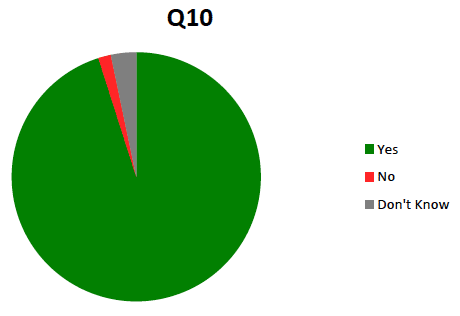
104. There was a clear majority of respondents to the questionnaire who took the view that there should be greater transparency when sheriffs impose a sentence, in terms of explaining the reasons for the sentence. A number of respondents indicated that this would help to dispel unrealistic public expectations about sentencing as it would make clear that sheriffs need to take into account a range of mitigating and aggravating factors as noted above [157] . In that sense respondents indicated it would serve to enhance public confidence in the judicial system and that appropriate penalties were actually being imposed. However, it was also put to us that given the judicial workload in summary conviction cases (perhaps 75 cases per day) written judgments are not provided (although if there was an appeal the sheriff would state the case) and it would therefore be a significant workload imposition to require this [158] . Nonetheless a respondent noted that sheriffs might choose to explain their reasoning orally but this was very much a matter of personal choice at present and even if they did so their comments may not be published [159] . Given the high profile nature of some of the cases one respondent indicated that it could be a positive step for sheriffs to do this [160] . However, it was also put to us that were written judgments to be required in wildlife cases, it would seem odd for such a requirement not to be imposed across the board as it would be hard to justify giving such a priority to wildlife cases [161] . So, as one respondent indicated, while this might be a useful exercise it would nonetheless potentially slow down the giving of judgments which in turn could have wider implications for the justice system and resources [162] . That respondent also noted that given sentencing was a matter for the courts it was not appropriate for the Scottish Government to indicate what was taken into account or not; rather it might be a matter for which the Scottish Sentencing Council should issue guidelines [163] .
Other issues / Wider context
105. Respondents and interviewees raised a number of other issues in the questionnaires and interviews. These included issues relating to the investigation and prosecution of offences, judicial attitudes to wildlife crime, coherence of wildlife crime legislation, adaptive management and preventive measures which included forms of licencing, training and education. Our focus in the review group was on penalties and we have therefore not included most of these issues in our report. We recognise that the issues we have not included are nonetheless important in terms of the wider context of the enforcement of wildlife crime and its prevention. We consider that the comments made on judicial attitudes to wildlife crime and the coherence of wildlife crime legislation are relevant to our review.
Judicial approaches to wildlife crime/environmental court
106. Some views were expressed on the need for more judicial training on wildlife crime issues although this would clearly be a matter for the Judicial Institute for Scotland and it was noted that certain organisations did produce good training material [164] . The current extent of judicial training on these matters was not clear [165] . It was noted that sheriffs appeared to be taking wildlife crimes more seriously and there was some indication that this was because of the level of public and governmental concern [166] . One organisation took the view that a specialist court or nominated sheriffs would help to ensure greater knowledge of the law and expertise in the field [167] . However, most interviewees took the view that the use of impact statements helped sheriffs to have a better understanding before sentencing [168] .
107. It was noted that the sheriff originally allocated to deal with the case of Procurator Fiscal v George Mutch, in which the accused was sentenced at Aberdeen Sheriff Court, 12 January 2015 had recused herself on the basis that she was a member of the RSPB. There was some questioning of whether sheriffs who were members of relevant sporting organisations had ever declared a conflict of interest in a case connected to game sports [169] . One organisation noted that it would be a matter for the sheriff to declare such an interest and recuse themselves [170] .
Coherence of wildlife crime legislation
108. The coherence of wildlife legislation was raised in a number of interviews partly because those interviewees had raised the issue in their questionnaire responses. This was in the context of ensuring that the law could be more readily understood and that its deterrent effect would be enhanced for that reason. All those who commented on this indicated that greater coherence was required. One individual indicated that this area of law needed to be tidied up and that it was disappointing that the Scottish Law Commission had not selected this area as a topic to consider for consolidation [171] . Two organisations also indicated support for consolidation [172] . The complexity of the law and the need to check amendments to WCA 1981 when consulting the legislation was criticised [173] . There was concern expressed by one individual that those who needed to understand the legislation, such as gamekeepers, could not do so because it was so complex [174] .
109. It was also suggested that codification rather than simply consolidation was required [175] . Codification would be a more systematic approach to legislative reform setting out clear purposes and guiding principles as well as incorporating operational controls. However, there was a recognition that even consolidation would help to clarify the purposes of the legislation [176] . As a minimum, greater consistency in penalty levels across the legislation was seen as valuable [177] .
Contact
There is a problem
Thanks for your feedback